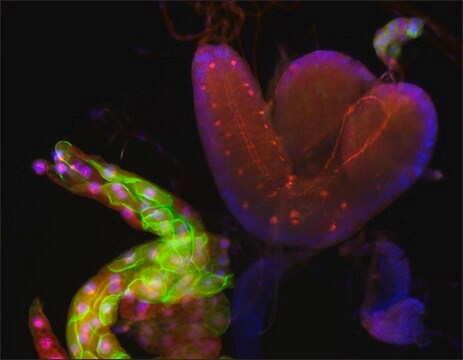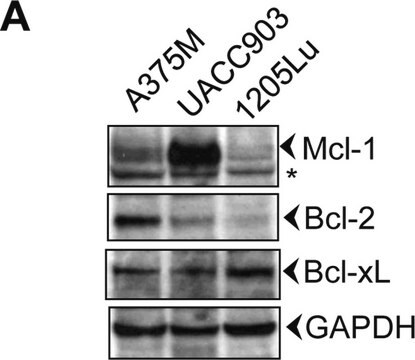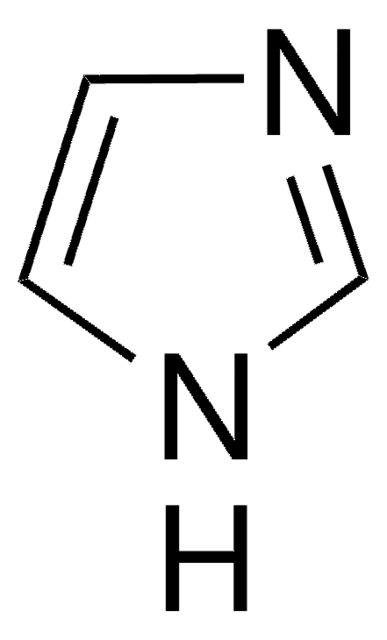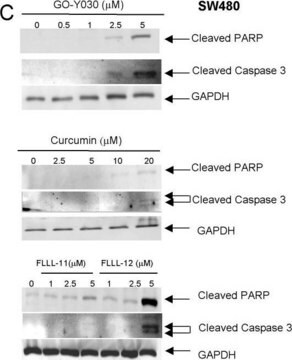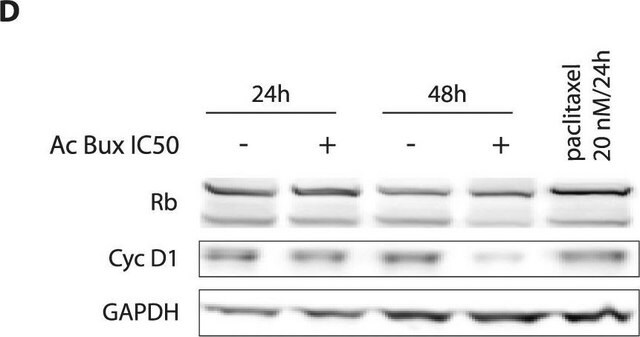추천 제품
생물학적 소스
rabbit
Quality Level
결합
unconjugated
항체 형태
affinity isolated antibody
항체 생산 유형
primary antibodies
클론
polyclonal
분자량
antigen ~56 kDa
종 반응성
mouse, human
포장
antibody small pack of 25 μL
농도
~1 mg/mL
기술
immunocytochemistry: suitable
western blot: 1-2 μg/mL using whole extract of mouse liver or human U87 cells
UniProt 수납 번호
배송 상태
dry ice
저장 온도
−20°C
타겟 번역 후 변형
unmodified
유전자 정보
human ... ATG5(9474)
mouse ... Atg5(11793)
일반 설명
ATG5 (autophagy related 5) is located on human chromosome band 6q21.
ATG5 was found localized to double FYVE domain containing protein 1 (DFCP1)- specific omegasomes.
Macroautophagy, usually referred to as autophagy, is a major pathway for bulk degradation of cytoplasmic constituents and organelles. Autophagy is an evolutionary conserved pathway seen in all eukaryotic cells. At least 16 ATG genes, required for autophagosome formation were identified in yeast by genetic screens. For many of these genes, related homologs have been identified in mammals. Atg5, also known as Apg5, is a 32 kDa protein essential for autophagy. Atg5 is covalently modified by Atg12, a ubiquitin-like modifier. This conjugation reaction requires ATP and two enzymes, Atg7 and Atg10, which are E1- and E2-like enzymes, respectively. The Atg12-Atg5 conjugate interacts non-covalently with Atg16. The Atg12-Atg5-Atg16 complex localizes to autophagosome precursors and plays an essential role in autophagosome formation. It has been reported that in addition to the role of Atg5 in the formation of autophagosomes, an Atg5 fragment produced by calpain cleavage has pro-apoptotic properties.
Rabbit polyclonal anti-ATG5 (C-terminal) antibody recognizes mouse and human Atg5-Atg12 complex by immunoblotting, ~56 kDa. Detection of the Atg5-Atg12 complex band by immunoblotting is specifically inhibited with the immunizing peptide.
면역원
synthetic peptide corresponding to amino acids 262-275 of mouse Atg5, conjugated to KLH via an N-terminal cysteine residue. The corresponding sequence differs by one amino acid in human.
애플리케이션
Anti-ATG5 (C-terminal) antibody has been used in immunohistochemical (IHC) staining.
Rabbit anti-ATG5 (C-terminal) antibody has been used for western blot analysis in U2OS cells. The antibody has also been used for immunoblot assays in CT26 and MCA205 cells.
Rabbit polyclonal anti-ATG5 (C-terminal) antibody is used to tag Atg5-Atg12 complex for detection and quantitation by immunocytochemical and immunohistochemical (IHC) techniques. It is used as a probe to determine the presence and roles of Atg5-Atg12 complex in the formation and function of autophagosomes. Rabbit anti-ATG5 was used as primary antibody for immunocytochemistry on HEK293 and Cos7 cells. Cells were fixed in 3.7% formaldehyde in 200 mM Hepes prior to antibody treatment.
물리적 형태
Solution in 0.01 M phosphate buffered saline, pH 7.4, containing 15 mM sodium azide.
면책조항
Unless otherwise stated in our catalog or other company documentation accompanying the product(s), our products are intended for research use only and are not to be used for any other purpose, which includes but is not limited to, unauthorized commercial uses, in vitro diagnostic uses, ex vivo or in vivo therapeutic uses or any type of consumption or application to humans or animals.
적합한 제품을 찾을 수 없으신가요?
당사의 제품 선택기 도구.을(를) 시도해 보세요.
Storage Class Code
12 - Non Combustible Liquids
WGK
WGK 1
Flash Point (°F)
Not applicable
Flash Point (°C)
Not applicable
개인 보호 장비
Eyeshields, Gloves, multi-purpose combination respirator cartridge (US)
가장 최신 버전 중 하나를 선택하세요:
이미 열람한 고객
S Polager et al.
Oncogene, 27(35), 4860-4864 (2008-04-15)
The retinoblastoma pathway is often inactivated in human tumors resulting in deregulated E2F activity that can induce both proliferation and cell death. Although the role of E2F in apoptosis is well characterized, little is known regarding its putative participation in
Elizabeth L Axe et al.
The Journal of cell biology, 182(4), 685-701 (2008-08-30)
Autophagy is the engulfment of cytosol and organelles by double-membrane vesicles termed autophagosomes. Autophagosome formation is known to require phosphatidylinositol 3-phosphate (PI(3)P) and occurs near the endoplasmic reticulum (ER), but the exact mechanisms are unknown. We show that double FYVE
Sylvain Ladoire et al.
Autophagy, 8(8), 1175-1184 (2012-06-01)
Autophagy is an evolutionarily conserved catabolic process that involves the entrapment of cytoplasmic components within characteristic vesicles for their delivery to and degradation within lysosomes. Alterations in autophagic signaling are found in several human diseases including cancer. Here, we describe
Eleanor M Cottam et al.
Autophagy, 7(11), 1335-1347 (2011-07-30)
Autophagy is a cellular response to starvation which generates autophagosomes to carry cellular organelles and long-lived proteins to lysosomes for degradation. Degradation through autophagy can provide an innate defence against virus infection, or conversely autophagosomes can promote infection by facilitating
Metastatic risk and resistance to BRAF inhibitors in melanoma defined by selective allelic loss of ATG5
Garcia F M, et al.
Autophagy, 12(10), 1776-1790 (2016)
자사의 과학자팀은 생명 과학, 재료 과학, 화학 합성, 크로마토그래피, 분석 및 기타 많은 영역을 포함한 모든 과학 분야에 경험이 있습니다..
고객지원팀으로 연락바랍니다.


